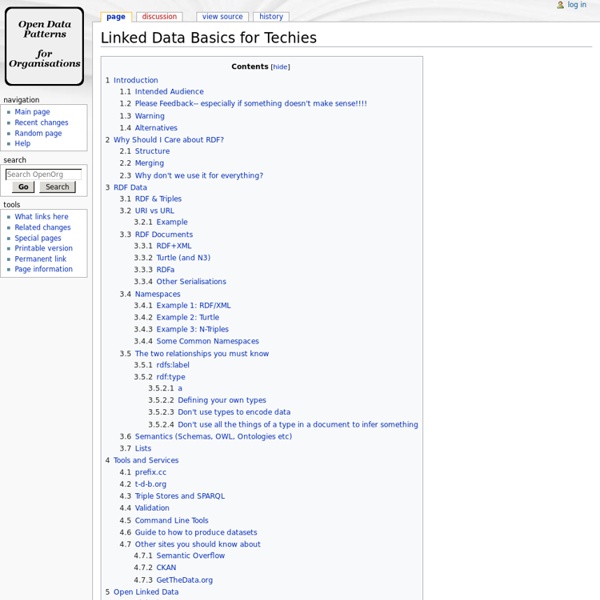Linked Data Basics for Techies - OpenOrg

http://openorg.ecs.soton.ac.uk/wiki/Linked_Data_Basics_for_Techies
Related: teaching: Linked Data
Understanding SKOS with an example
Ontology : An ontology formally defines a common set of terms that are used to describe and represent a domain. An ontology is domain specific, and it is used to describe and represent an area of knowledge. It contains terms and the relationships among these terms. There is another level of relationship expressed by using a special group of terms: properties.
owl:sameAs
owl:sameAs is an OWL built-in property used to link an individual to an individual. Such an owl:sameAs statement indicates that two URI references actually refer to the same thing: the individuals have the same "identity". In N3 syntax = is a synonym for owl:sameAs.
MO - the Movie Ontology
In the following, the movie ontology MO is described. The overview of the defined concepts are presented in Figure “Concept overview of the movie ontologyâ€. Overview of the movie ontology domain Movie related concepts
Documentation - COEUS
COEUS has now the capability to share your data in the Nanopublication format. With this new plugin you can transform your integrated data in this prominent format by following the next steps: Go to the Nanopublication Section on the Dashboard. Select the concept root and related data that will generate the nanopublications.
TAPoR
TAPoR 3 Discover research tools for studying texts. Filters: Narrow the Selection of Tools
URL, URN, URI, IRI - Why So Many?
Computer guys tend to lack imagination, especially when they work with acronyms. This may lead to a lot of funny stuff. Let’s look at the following acronyms, for instance: URI, URN, URL, and IRI. In interviews I like to ask this question and only once a guy was able to give an almost 100% correct answer. Somehow, I was not particularly surprised about it, as even widely adopted specifications contain subtle mistakes.
Access Innovations
Q? What can I do with a taxonomy? A. You can use a taxonomy in many ways: Provide a common language basis for all activities within an organization.Coordinate documents, people, and activities by using the same descriptive terminology throughout.Categorize content (documents) using taxonomy terms.Search the data in your database by taxonomy term.Use taxonomy terms as metadata for HTML records.Use the taxonomy as a browsable topic list in a portal or web site. For more detail on the business utility of a taxonomy, see this Taxodiary article.
Linked Data
OCLC has been working with Linked Data for several years. As can be seen from the publishing of the Dewey Decimal Classification (DDC), the Virtual International Authorities File (VIAF) and Faceted Application of Subject Terminology (FAST) as linked data. The release of experimental WorldCat Linked Data in June 2012 was another milestone in the exposure of WorldCat.org bibliographic metadata as linked data. The OCLC linked data strategy is an evolving mix of Linked Open Data (LOD) and Linked Enterprise Data (LED). This means that we will have incremental releases of new data and services, as we better understand how to model and publish the information.
Related:



